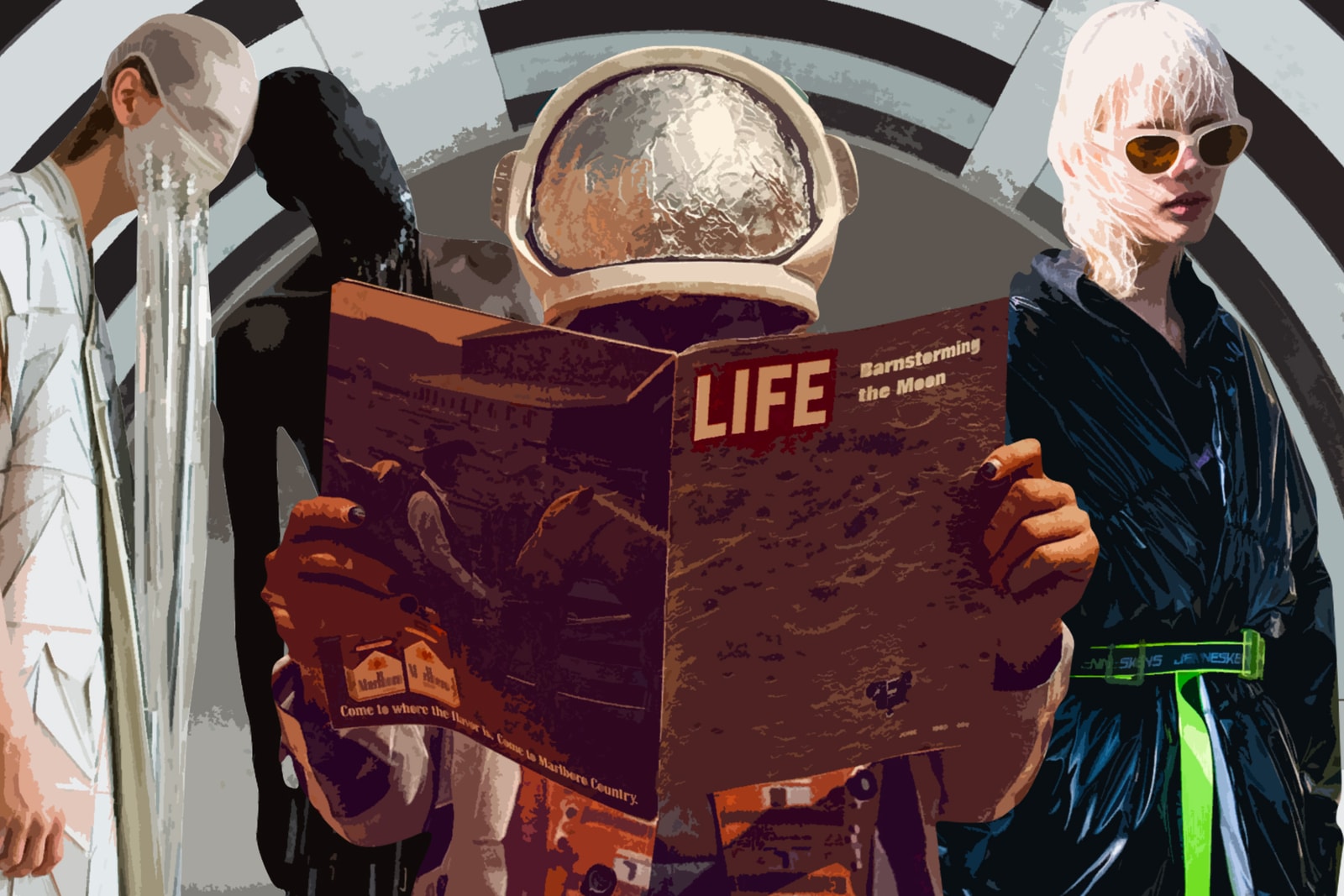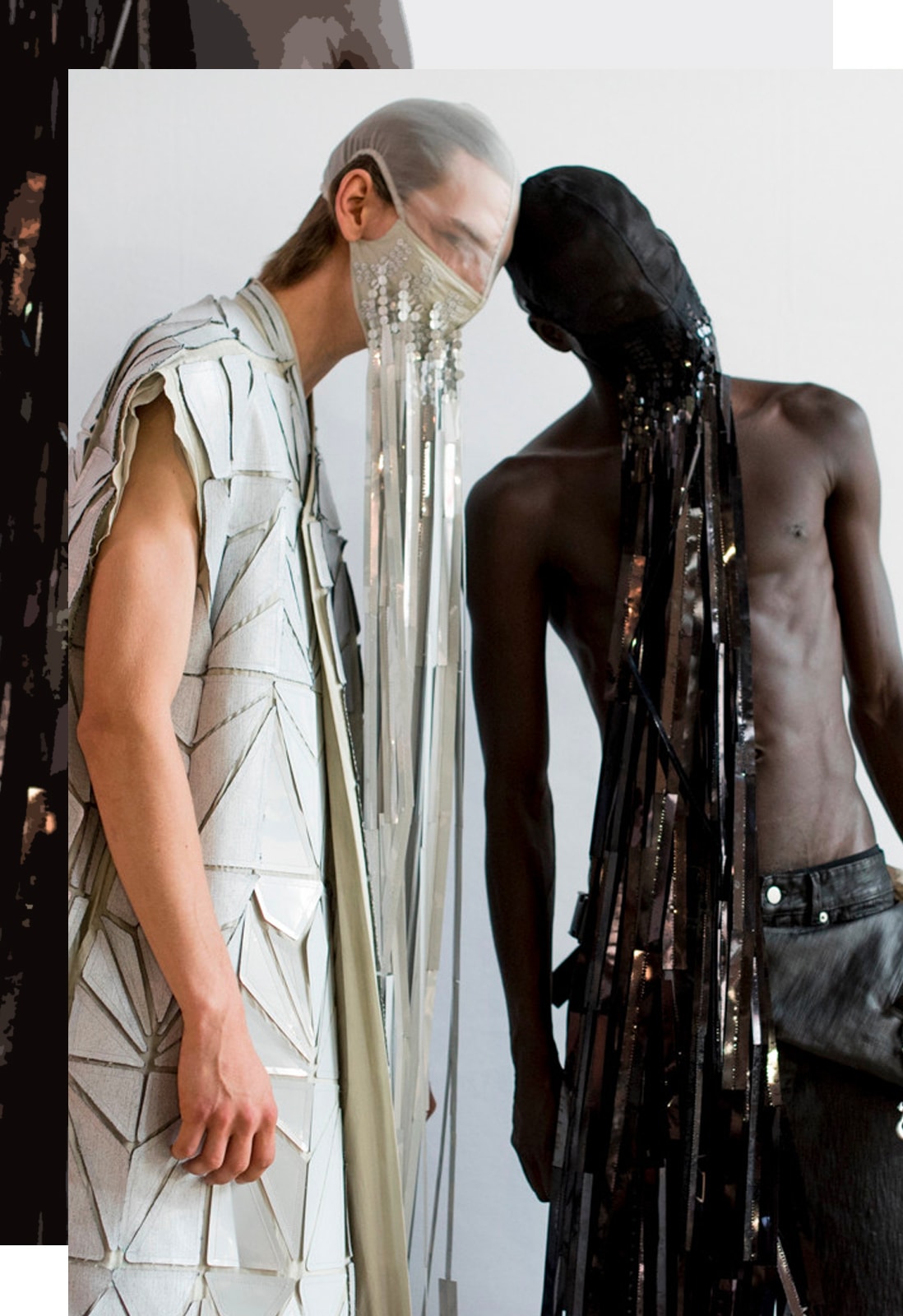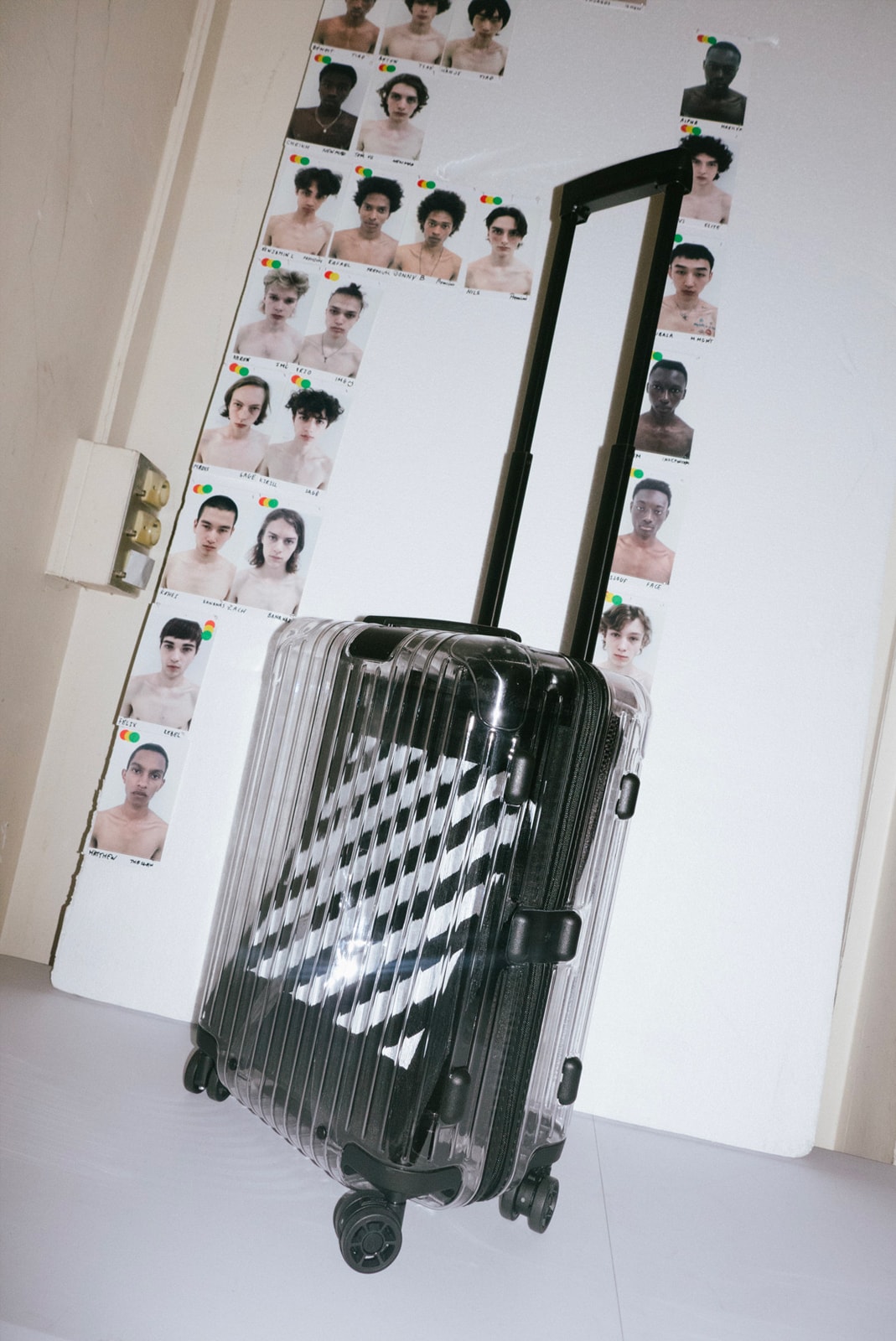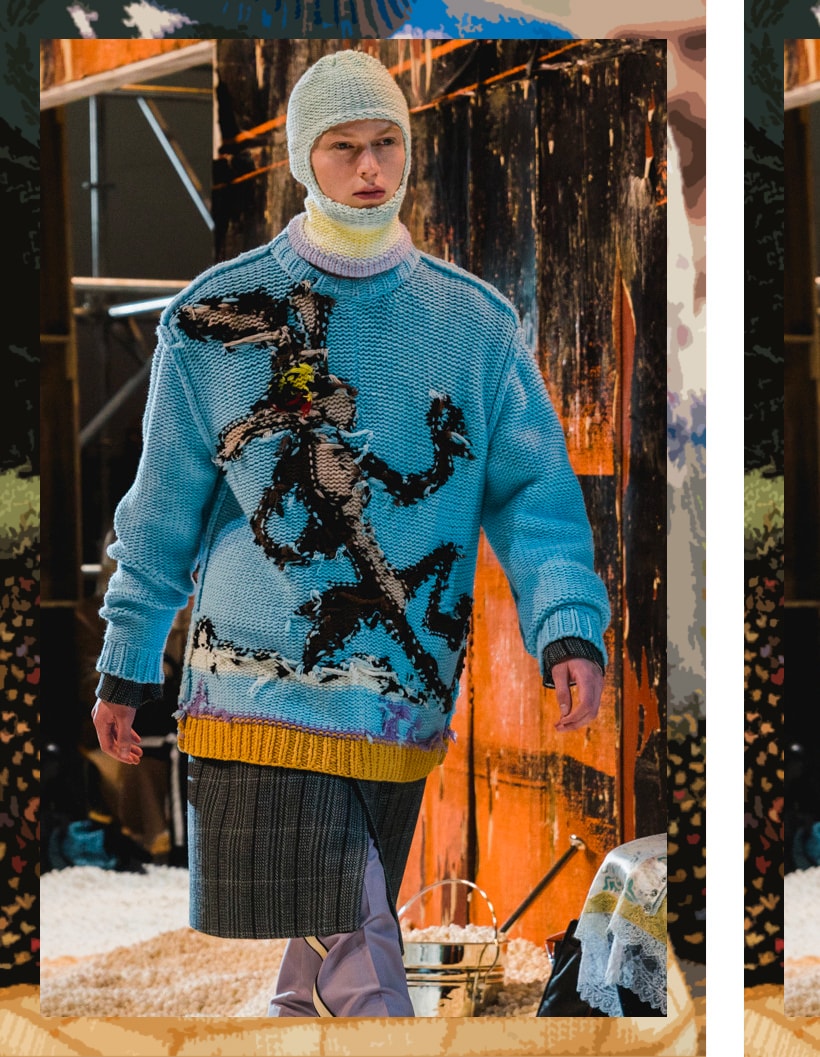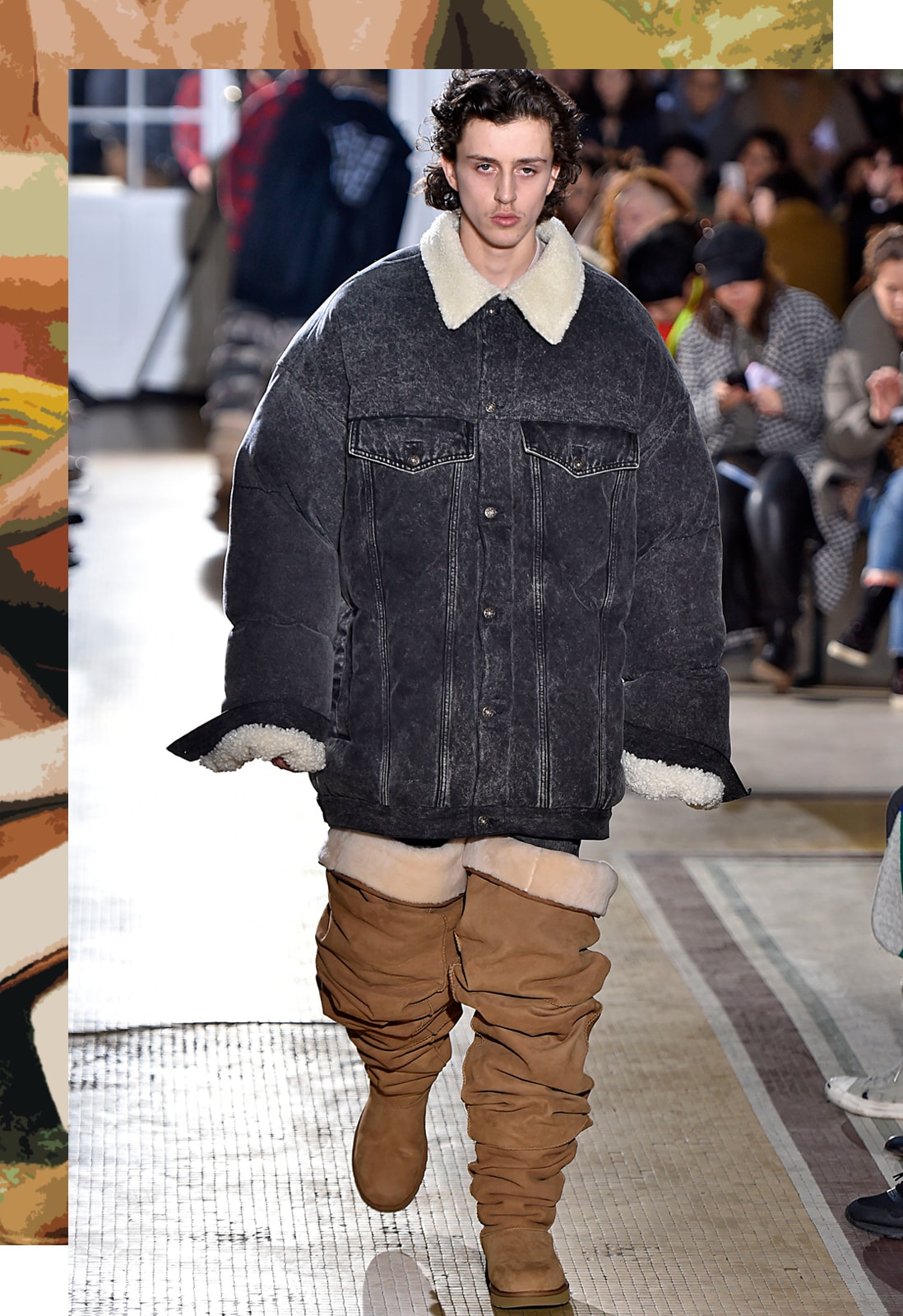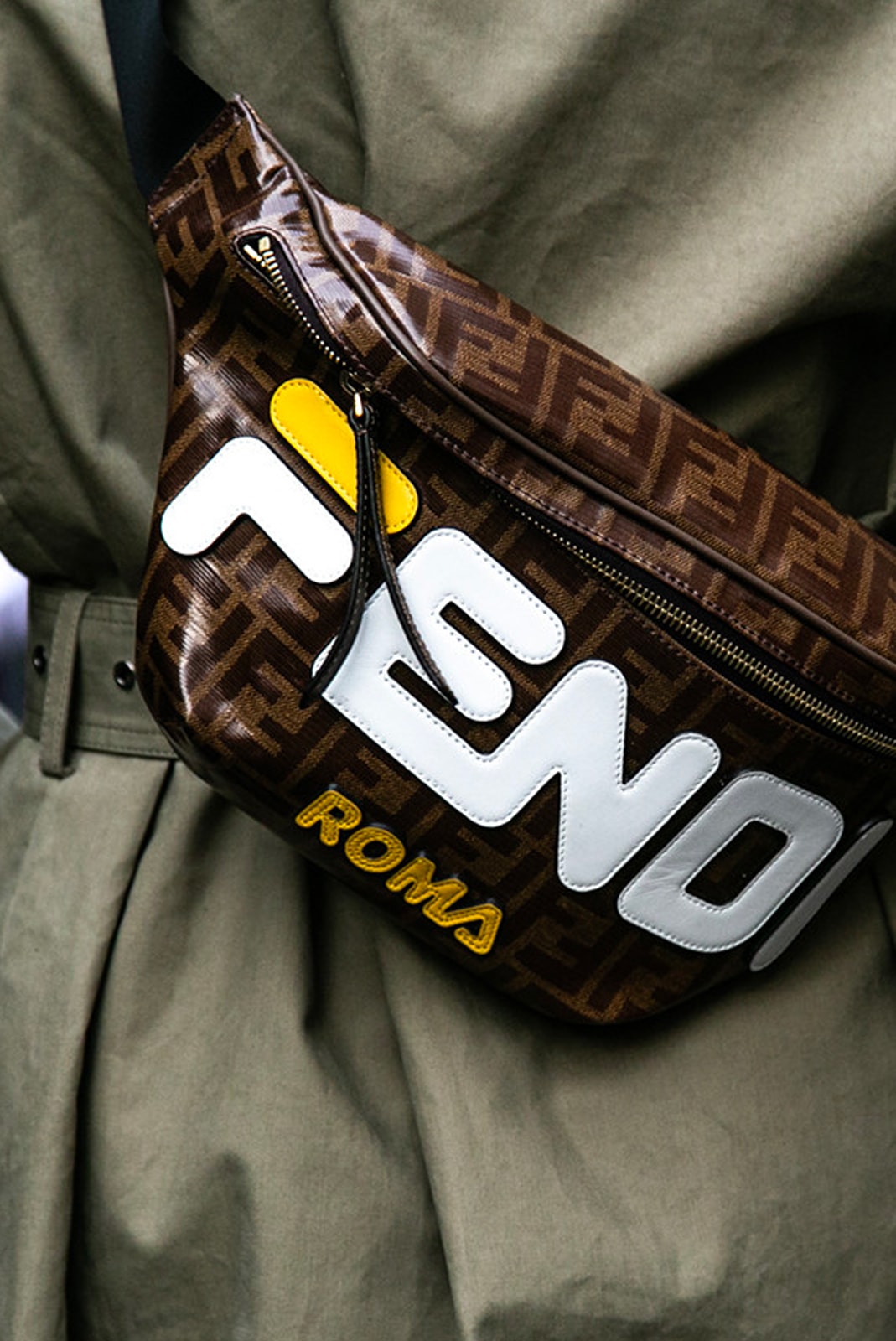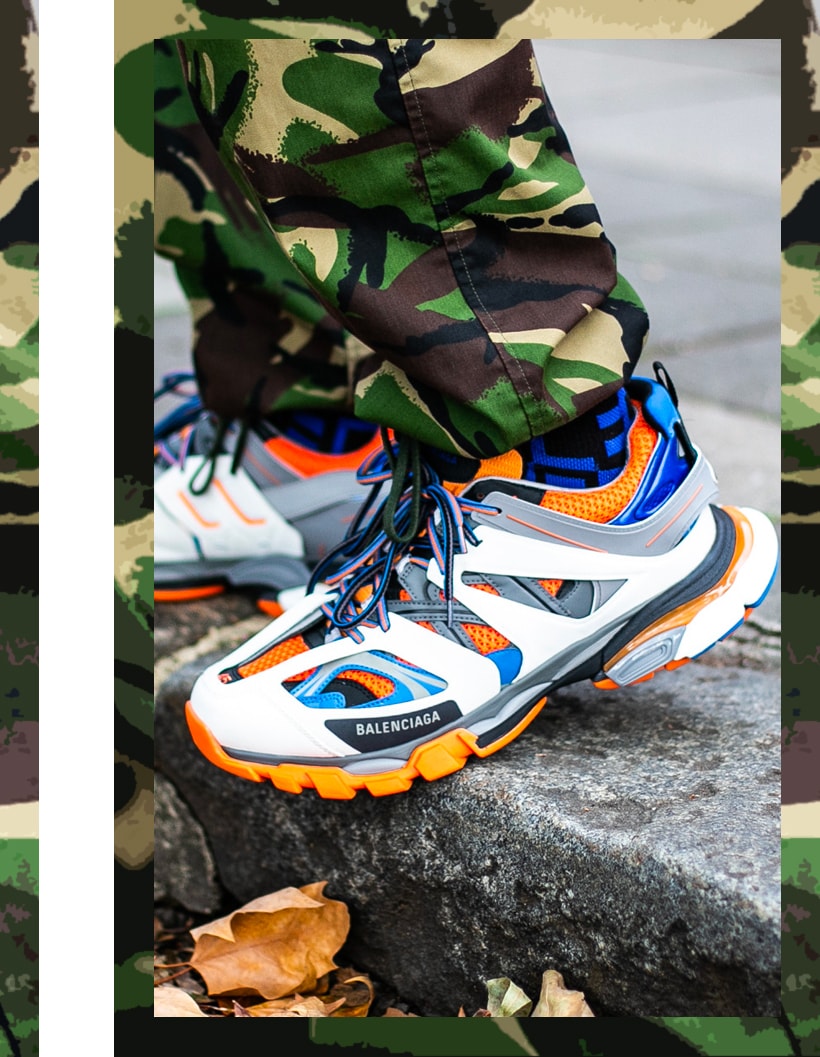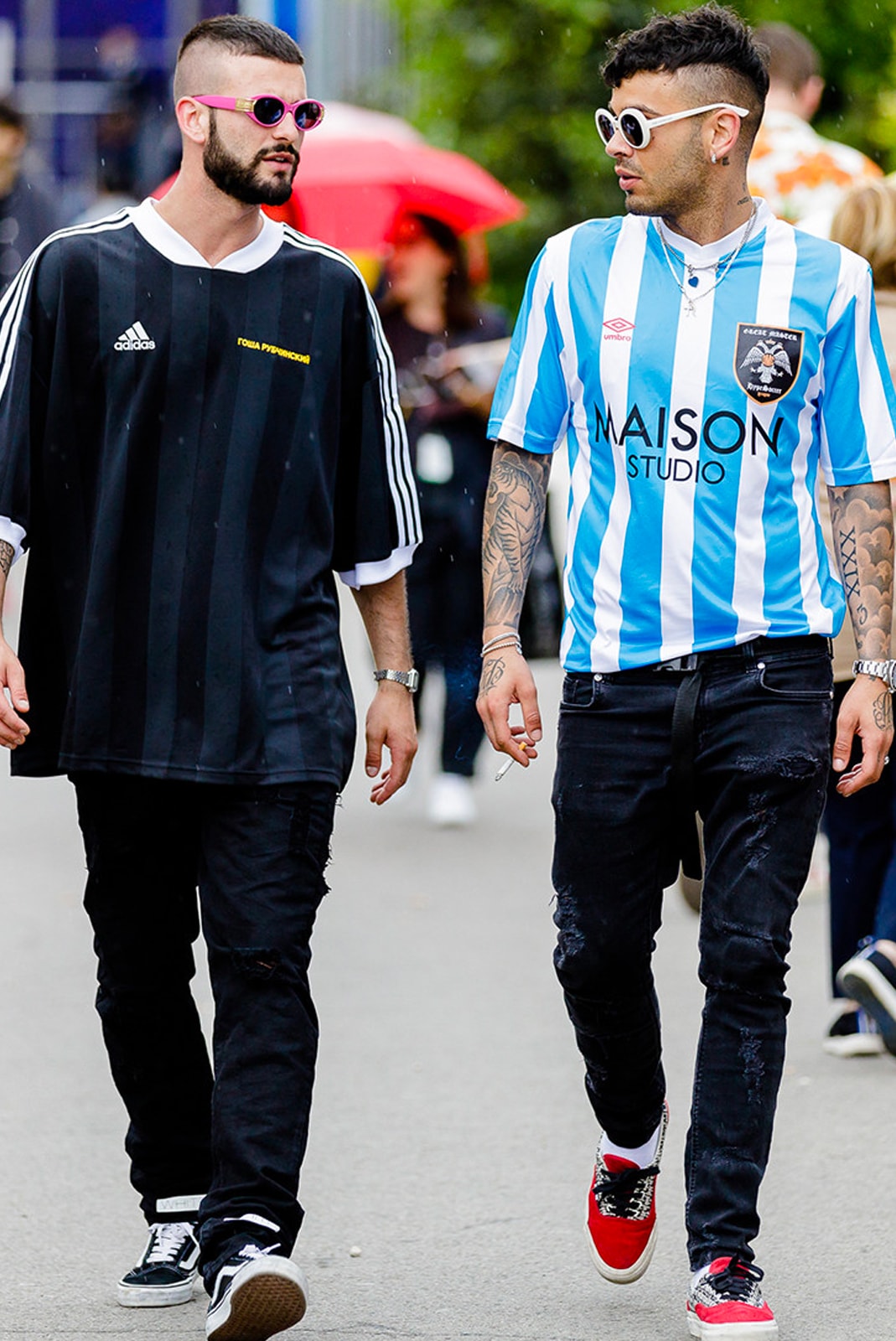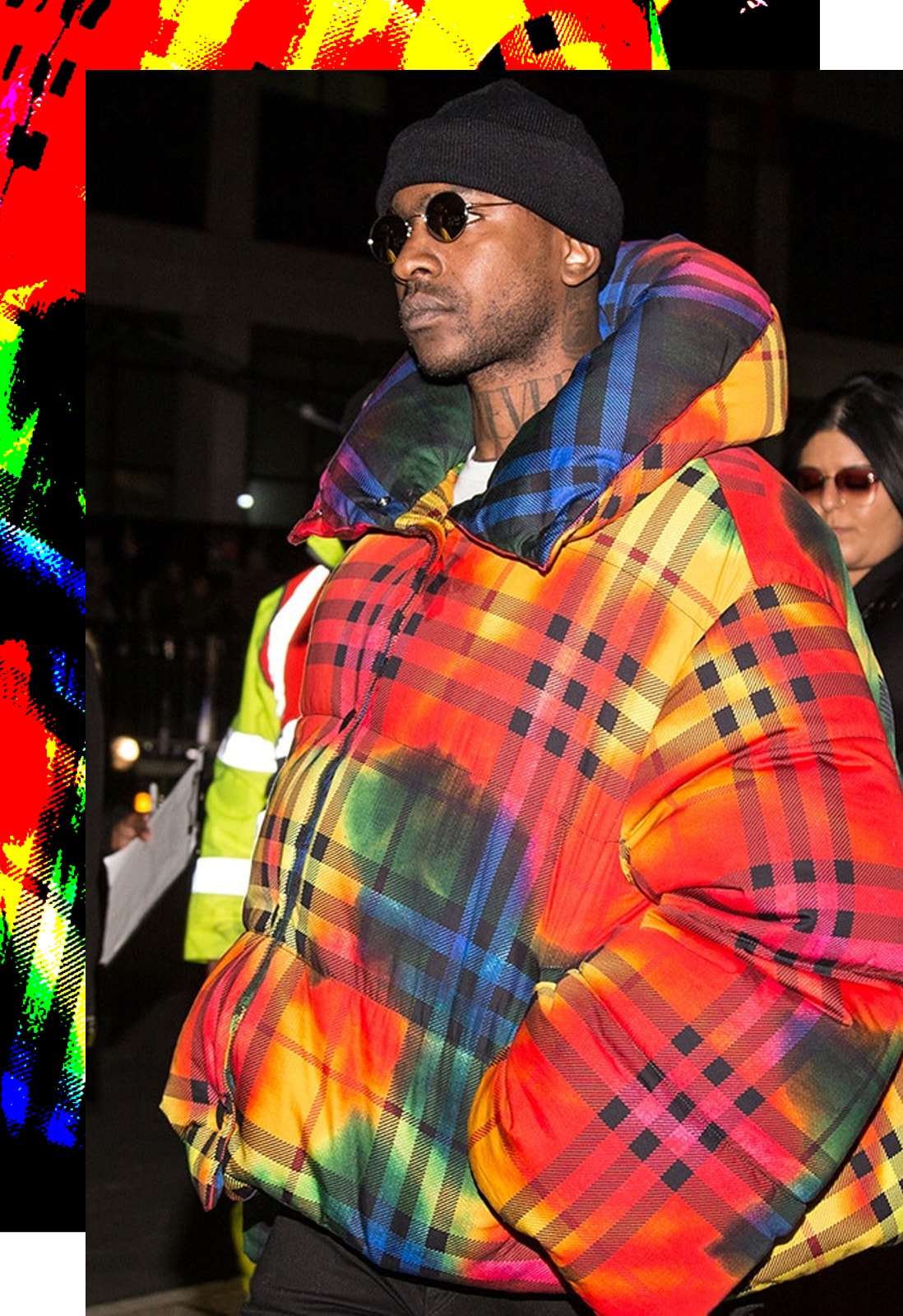It’s that time. We’re looking back at the best ads of 2018, a year when marketing truly ran the full spectrum, from silly and sarcastic to weighty and wonderful.
With all the industry hand-wringing of late about whether creative agencies are a dying breed, one might have expected a drought of ambitious advertising in 2018. Instead, we saw that when bold marketers put their faith in provocative agencies, they can create work that doesn’t just reflect culture but also drives it forward.
As a reflection of how much great work there was to talk about this year, we’re expanding our usual Top 10 list to a Top 25, and we’ll be creating a separate list just for our favorite stunts, activations and innovations.
So let’s get to it. Here are Adweek’s picks for the Top 25 ads of 2018:
25. KFC Hong Kong | “Hot and Spicy” Agency: Ogilvy Hong Kong

These print and outdoor ad images are classic art direction at its best: simple in concept, flawless in execution and (once you catch the concept) impossible to stop staring at. By replacing the fire in different images with KFC’s Hot and Spicy fried chicken, Ogilvy Hong Kong created a campaign that sparked praise among consumers and creative peers alike. While Ogilvy didn’t invent the idea of using fried chicken as fire (a technique that’s been popping up in different parts of the creative web for years), they certainly cooked it up perfectly.


24. Nat Geo | “Nujeen” Agency: 72andSunny
The story of a young refugee who escaped Syria in a wheelchair is an incredible one to hear or read—but to see the young woman herself, Nujeen Mustafa, re-enacting her impossible odyssey is something truly special. Nat Geo and agency 72andSunny made it happen, thanks to Mustafa’s extensive cooperation and the powerful storytelling of director Reed Morano, best known for her work on The Handmaid’s Tale. “I wasn’t supposed to see the bright side of my journey,” says Mustafa, who has cerebral palsy, in her narration of the spot. “So I made it an adventure, and discovered all sorts of new things.”
23. Greenpeace Canada | “Don’t Suck the Life From Our Oceans” Agency: Rethink

The debate over the destructive role of single-use plastics on ocean life reached critical mass this year, with major brands including Starbucks pledging to phase out plastic straws. Perhaps the most powerful visual to make the case for this consumer shift came from Greenpeace Canada and agency Rethink, whose print ads feel like a punch in the throat to each viewer. It’s a powerful, unforgettable image—and one that sadly isn’t hyperbole.
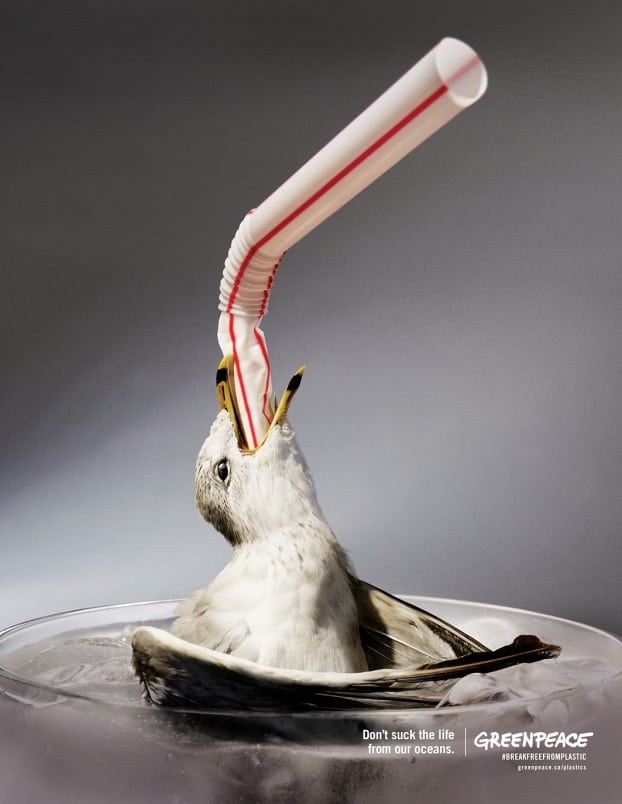

22. Newport Beach Film Festival | “Quota” Agency: The Garage
Promotional videos for film festivals have become some of the most fun and freaky ads in recent years, and Newport Beach Film Festival has certainly been one of the leaders in the trend. For this year’s festival, director Jillian Martin created a mini-masterpiece with “Quota: Who Made the Cut.” It’s a fantastic feat of short-form storytelling with an ending that … well, let’s just say it makes its point in a way you won’t forget. Martin was featured on this year’s Adweek Creative 100 as an emerging director to watch.
21. Bud Light | “Oracle Susana” Agency: Wieden + Kennedy New York
While “Dilly Dilly” may have been a dominating force in both advertising and pop culture this year, picking a best ad is a challenge. Bud Light’s Super Bowl outing, “Bud Knight,” was memorable and featured the dry wit and subtle acting that have made the campaign a hit. But for our money, the best spot was “Oracle Susana,” created with a clever blend of Spanish and English aimed at appealing to World Cup audiences. The ad isn’t just funny and memorable; it also showed that the Dilly Dilly campaign still had quite a lot of area to explore. At Adweek’s Elevate: Creativity event earlier this year, Wieden + Kennedy New York ecd Karl Lieberman said the creative team behind the ads pictures the campaign taking place on a map similar to the sprawling geography of Game of Thrones. “Oracle Susana” was the first foray into this wider world.
20. Monoprix | “The Worst Song in the World” Agency: Rosapark
Imagine being presented with this creative challenge: Write a song that’s so bad, it could believably called “The Worst Song in the World.” But don’t make it so bad you can’t listen to it all the way through. In fact, try to even make it addictively catchy in the way only truly great bad songs—”We Built This City on Rock and Roll,” “The Final Countdown,” etc.—can be. French agency Rosapark and its production partners were up that challenge, crafting a hilariously awful track for grocery chain Monoprix. The gag is that the ad’s protagonist can’t stop listening because her hands are full of grocery bags—which they wouldn’t be if she used the delivery service being advertised. But even if you don’t remember the payoff, you’ll always, always remember the song.
19. Apple | “Unlock” Agency: Furlined
Unquestionably, 2018 was an amazing year for Apple’s creative marketing, as you’ll see more than once again in this list. One exceptionally crafted piece that’s often overlooked, though, is one made by production house Furlined to launch the iPhone X. With a breathless pace and effortless style, “Unlock” is a feast of visual popcorn as a young woman learns that her glance can unlock the new iPhone—and maybe everything else?
18. Kiwi | “Greatness Starts With a First Step” Agency: Ogilvy Chicago

There’s a certain subset of advertising lovers who will always fetishize long-form copy, but in truth the format is often frought with self-indulgence and an eye-rolling level of earnestness. But long-copy skeptics and believers alike can agree on Ogilvy Chicago’s fantastic series of print ads for shoe polish brand Kiwi. Each shows the real footwear of a famous figure, along with a detailed story about the first steps that took them on their history-making journeys. In a world where ads are lucky to get your attention for 6 seconds, these are worth enjoying in every fascinating detail.
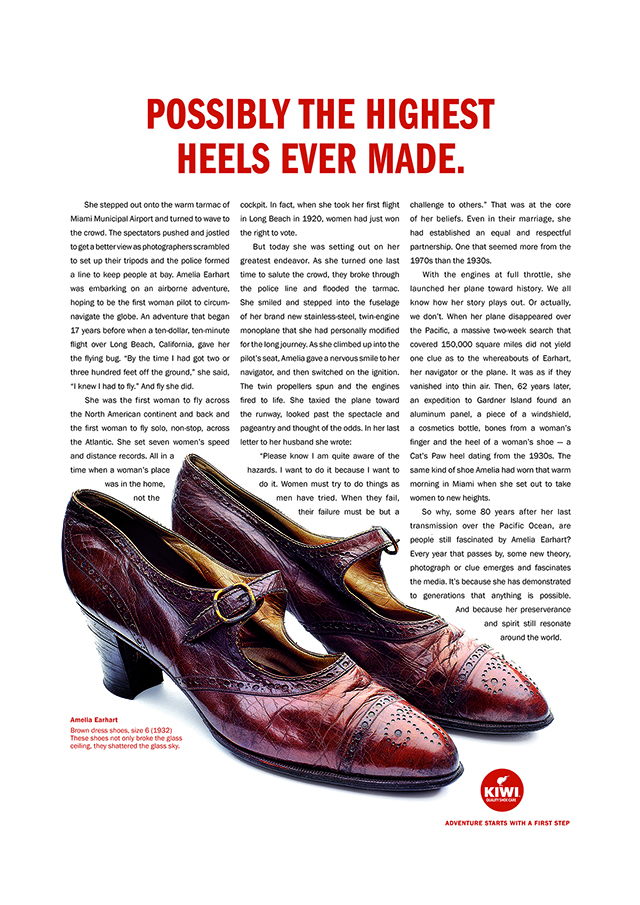
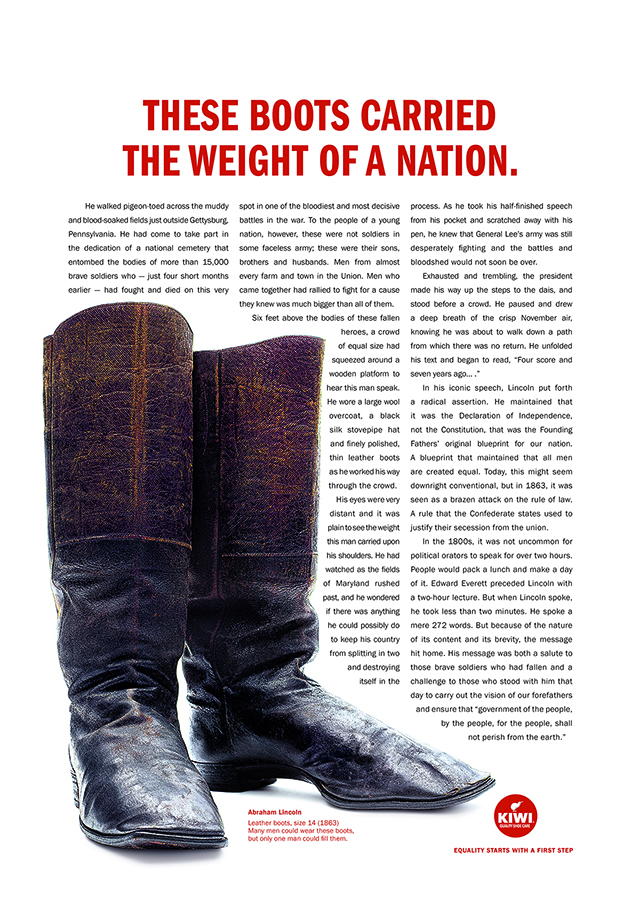
17. MJ Hegar for Congress | “Doors” Agency: Putnam
The wave of Democrats who ran for office in 2018 will likely be best remembered for regaining control of the U.S. House from the Republican majority, but they’ll also have another legacy specific to the world of political advertising. It was an incredible, revolutionary year for grassroots political ads that came in all shapes and sizes, but with one recurring theme: they created an instant, emotional connection between the viewer and the candidate. Alexandria Ocasio-Cortez used long-form, highly personal storytelling to help fuel her establishment-rattling rise from New York bartender to Congress’ youngest female member ever. But even more compelling was “Doors,” the captivating ad from Texas Democrat and Air Force veteran MJ Hegar. She fell short of victory, but the ad gave her campaign an immense boost in national awareness—and will be used as a role model for countless campaigns in the years to come.
16. Stabilo Boss | “Highlight the Remarkable” Agency: DDB Dusseldorf
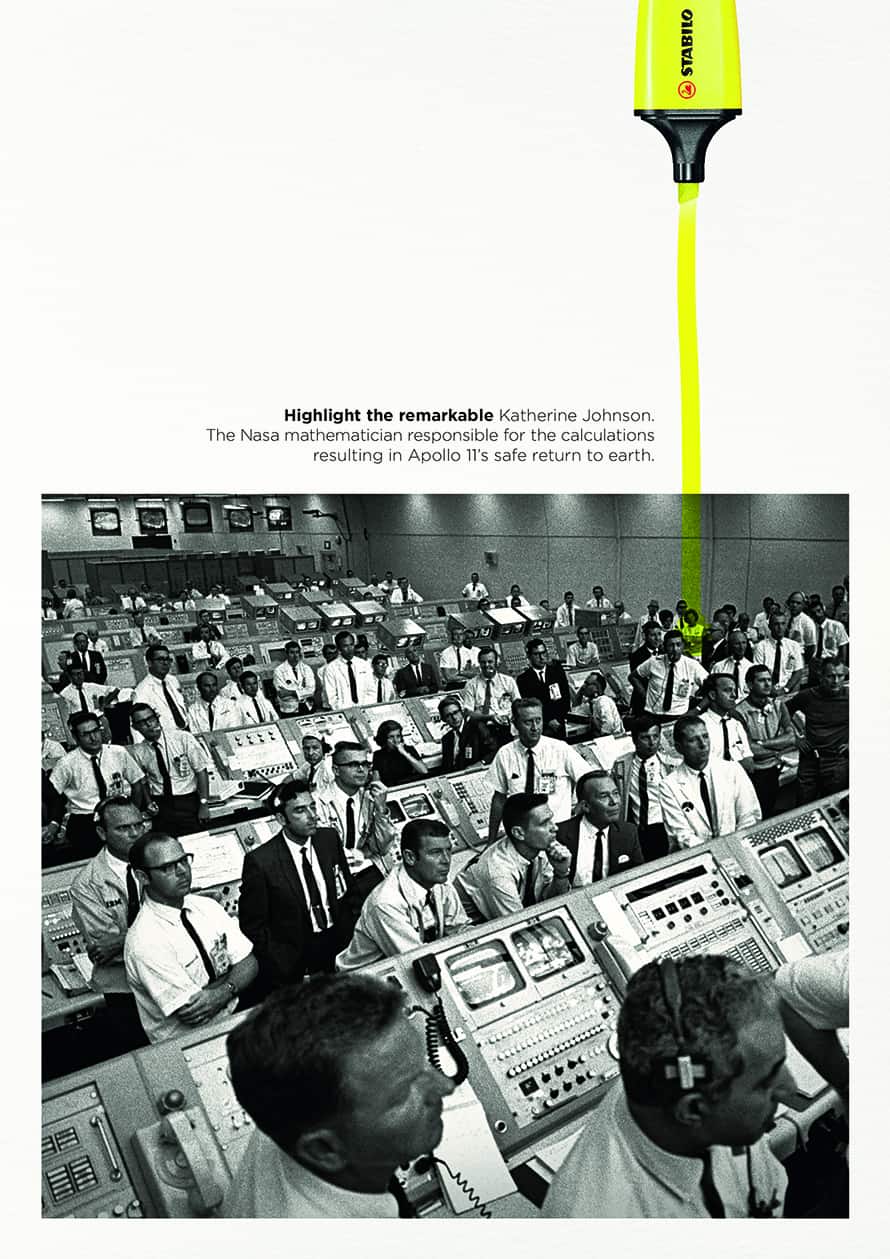
Award shows most often celebrate successful advertising, but in the case of DDB Dusseldorf’s “Highlight the Remarkable,” a win at the Cannes Lions was actually the starting point on a road to worldwide acclaim. After this year’s festival, the campaign—highlighting the women who might be otherwise overlooked in a historic photo—was shared passionately across social media.
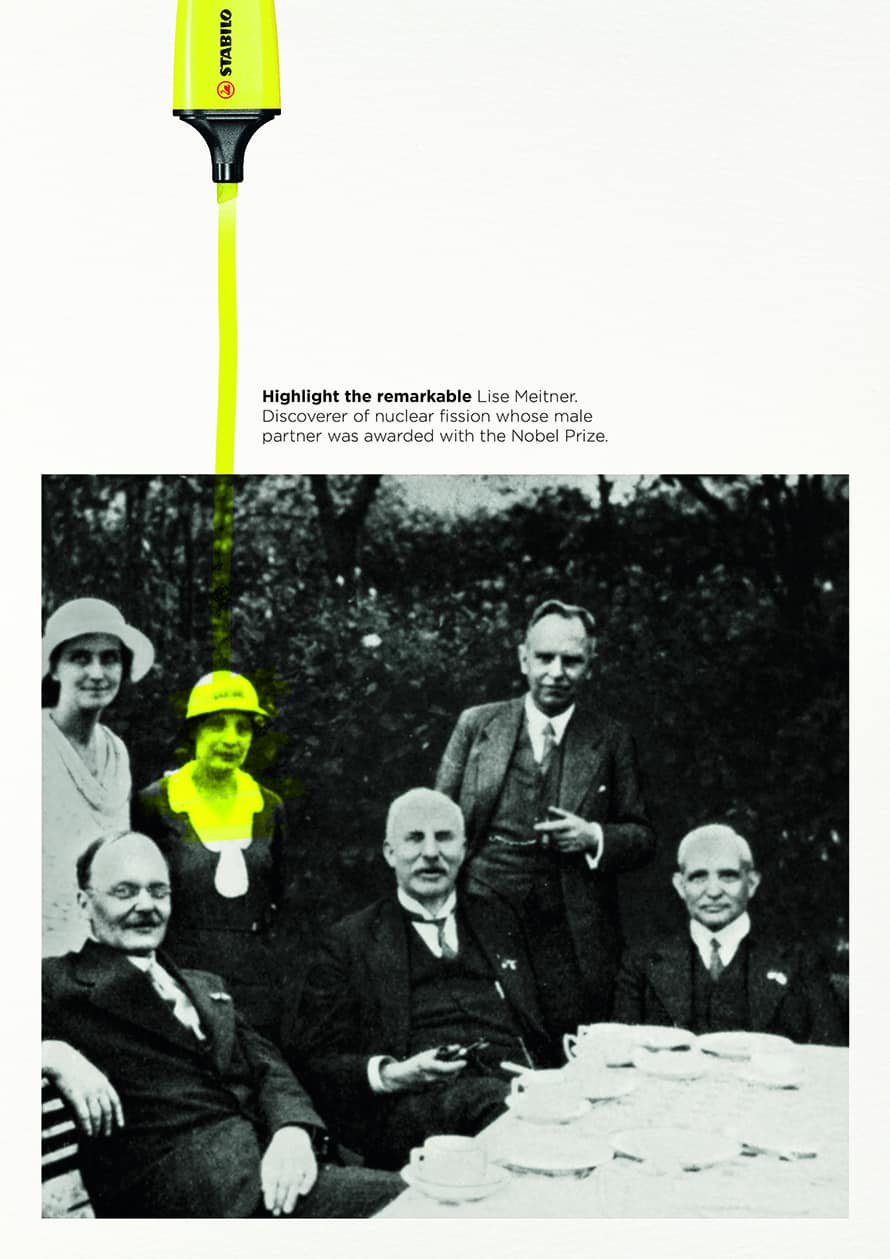
15. Taco Bell | Web of Fries, Parts 1 and 2 Agency: Deutsch
In truth, you’ve probably never wondered why Taco Bell doesn’t serve fries. But that question still made great fodder for Deutsch’s two-part campaign of hilarious movie trailers for a fictional film franchise called Web of Fries. Part 1 is a pitch-perfect sendup of conspiracy films where a shadowy occult hand guides the inner workings of the world around us. In Part 2, we vault into the dystopian near future to see how this conspiracy has sparked a fast food war—one that ’90s film lovers will recognize as the setup to 1993’s Demolition Man starring Sylvester Stallone. We didn’t know we wanted this, but here we are. Now pass the nacho dip.
14. Elkjøp | “To Give More” Agency: Nord DDB
What happens when you create a holiday ad for an electronics retailer that feels absolutely nothing like a holiday ad for an electronics retailer? In the case of Scandinavian chain Elkjøp, you get an unexpectedly emotional and cinematic tale of a young girl who discovers that an older, reclusive relative has lived a life of adventure, love, loss and regret, all of which comes to light when she discovers the broken mementos of his past. The ad is lovely and powerful on a level that few ads could ever hope to accomplish.
13. Shiseido | “The Party Bus”
Cosmetics brand Shiseido creates some of the most riveting and unexpected marketing on Earth, with each new ad taking you in a new and surreal direction. This year, Shiseido created a piece of commercial art with its Halloween-themed ad “The Party Bus,” which unfolds like a lyric-less opera as we watch a young woman choose between two romantic options. The setting and costumes are lovely, but it’s the animated makeup that brings a new and fun level of emotional depth to the ad.
12. OKCupid | “DTF” Agency: Wieden + Kennedy New York
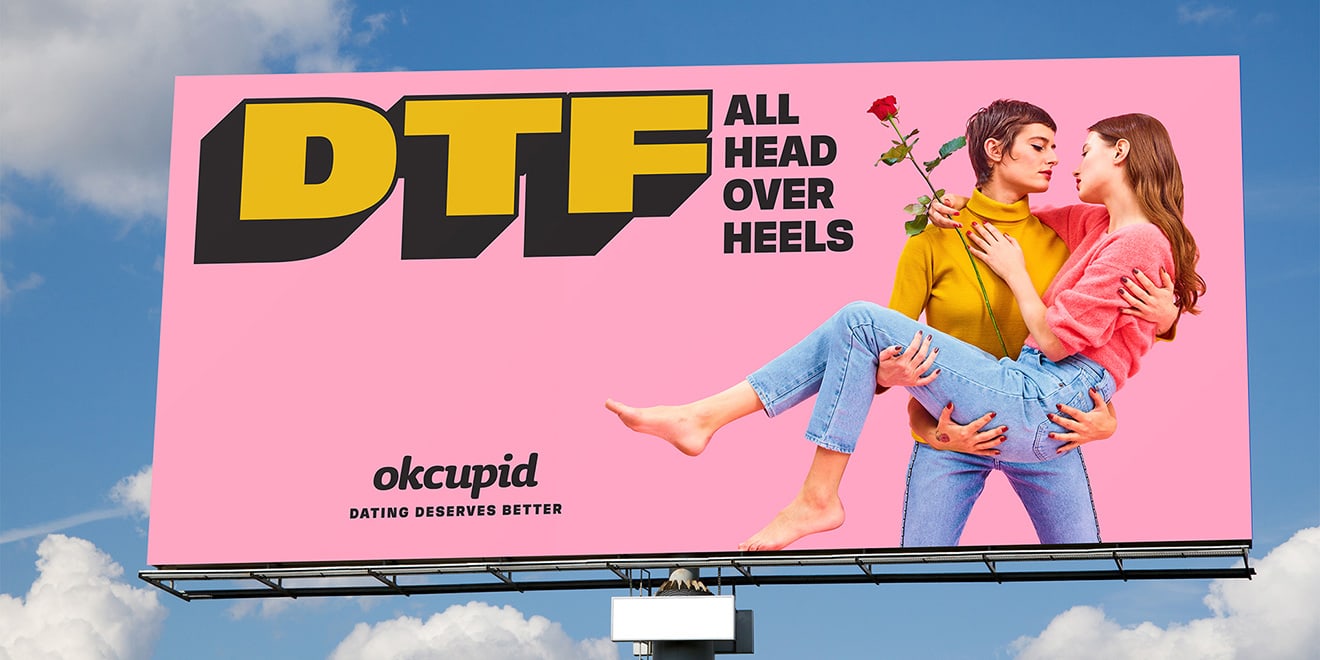
For years, “DTF” (“Down to Fuck”) has been a shorthand often used to slut-shame or demean women, so it’s not exactly the first expression you’d expect to find in a marketing campaign for a progressive-leaning dating app. But OKCupid and W+K New York reclaimed the term by celebrating a wide array of new meanings in their outdoor-focused campaign. Exceptionally illustrated with colorful visuals by artist Maurizio Cattelan and photographer Pierpaolo Ferrari, the campaign proposed looking for partners who Are Down to Farmers Market, Down to Fire Up the Kiln, Down to Finish My Novel or Down to Four Twenty. OKCupid CMO Melissa Hobley told Adweek the campaign boosted social mentions of the dating resource by 50 percent.
11. Getty Images | “Endless Stories” Agency: AlmapBBDO
A b-to-b campaign that you’d actually want to watch, much less one good enough to win five Lions at Cannes, is a rare treat. But that’s what we got from Brazil’s AlmapBBDO and Getty Images with “Endless Stories,” a retro-cool recap of surprisingly interconnected events that happened on March 8, 1971. The spot takes narrative video to a new level of difficulty, requiring far more research than the usual historic spot and, of course, requiring plenty of Getty Images to make the point that you can get a shockingly 3-dimensional view of almost any given day thanks to the stock art service’s exhaustive collection.
10. Nike | Nothing Beats a Londoner Agency: Wieden + Kennedy London
Do I know everything that’s happening in this ad? I do not. Do I understand even a majority of the dialogue? I do not. Do I catch any of the geographic references? Not a one. And yet this superlatively London spot, directed by the Megaforce collective, is an absolute joy to watch again and again. Unfortunately the ad and its related campaign were quickly mired in legal disputes over variations of trademarks on the term “Londoner,” and the spot was officially pulled from Nike’s channels a month after launch. But it lived on in the hearts of advertising lovers and ended up taking home the first Grand Prix in the Cannes Lions’ newest category, Social and Influencer Lions.
9. Apple | “Share Your Gifts” Agency: TBWA\Media Arts Lab
Apple’s holiday ads in recent years have all been quite delightful, but this year’s outing was a piece of such intense craft and rich storytelling, it immediately earned a special place in the pantheon of great Apple ads from across the brand’s history. The musically enchanting animation tells the story of a young, creative woman who spends a year on something that she’s just a bit too nervous to unveil to the world—until her closest companion gives her a nudge. With a relatable moral, exquisitely crafted visuals that mix physical miniatures with computer animation, and more Easter eggs than probably any other ad in 2018, it’s a spot you’ll want to watch over and over.
8. Libresse | “Viva La Vulva” Agency: AMV BBDO
Last year’s #BloodNormal campaign for the Libresse/Bodyform brands of feminine hygiene products was an unapologetic bull in the china shop of marketing’s decades-long approach to women. While it boldly reclaimed menstrual blood as a natural part of human life that should be devoid of stigma, the campaign’s follow-up in 2018—“Viva La Vulva”—took a more celebratory tone of vaginal pride by praising the vulva as not just natural and unique but also beautiful and regal. London agency AMV BBDO’s video joyously animates just about everything into a vulva, all singing Camille Yarbrough’s “Take Yo’ Praise,” a track many might only have heard before through its sampling on Fatboy Slim’s “Praise You.” It’s an ad that’s sure to make some—probably even quite a few—viewers uncomfortable, but it’s perfectly crafted to start the kind of conversations that women and the marketing industry need to be having.
7. John Lewis | #EltonJohnLewis Agency: adam&eve DDB
Elton John was everywhere this year, both digitally and physically thanks to his Farewell Yellow Brick Road tour. So even a devoted fan of Sir Elton might be forgiven for feeling a bit of fatigue near the end of the year. But then along came #EltonJohnLewis, a masterpiece of mini-biography that traces the singer-songwriter’s career from his last days of touring all the way back to his childhood and a Christmas that helped set him on his path to glory. It was touching, heartwarming and, in all other ways, everything a good holiday ad should be.
6. Ikea | “Pee Ad” Agency: Åkestam Holst
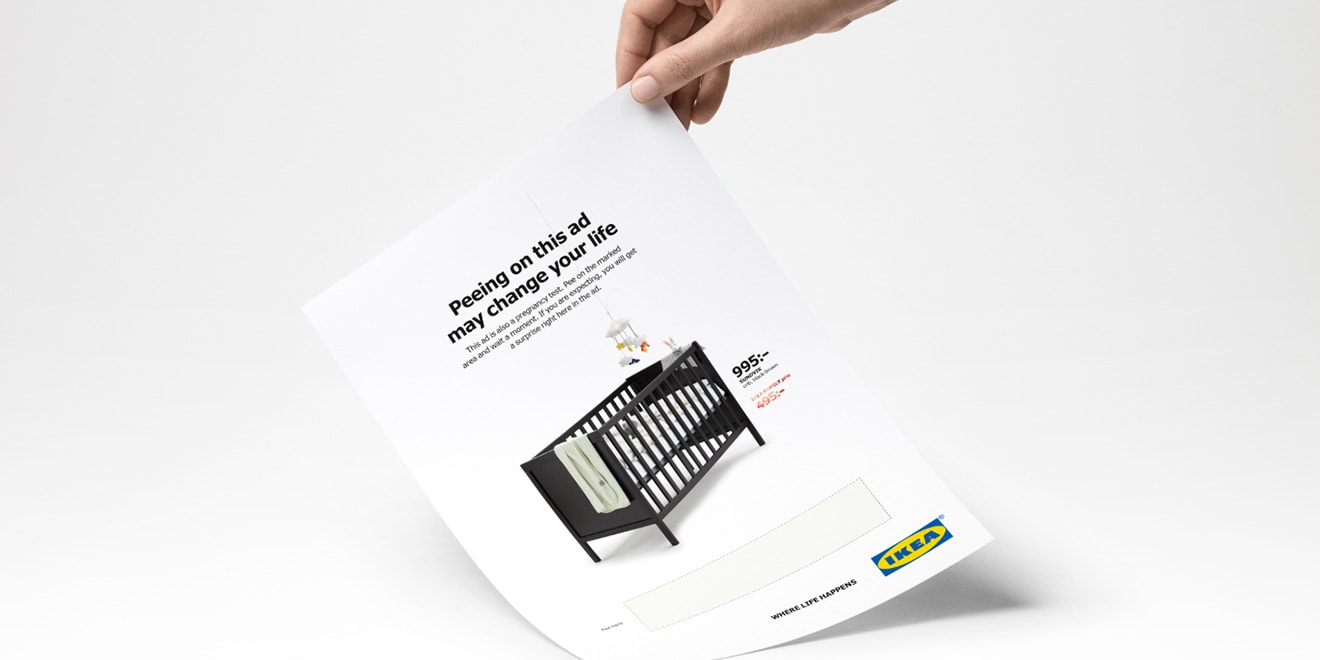
“Peeing on this ad may change your life” was one of the more unexpected ad headlines of 2018. Stopping just about anyone in their tracks, the Ikea “Pee Ad” doubled as a pregnancy test by changing color if your urine contained pregnancy markers. The ad would then reveal a discount on Ikea cribs (because who doesn’t want to redeem a coupon they’ve peed on?). Rolling out right at the beginning of the year, this one set the bar nice and early for how weird advertising could get in 2018, and in the end, no other ad came close. At the Cannes Lions, the ad won two golds in the print category: one for retail and one for innovation.
5. Amazon | “Alexa Loses Her Voice” Agency: Lucky Generals
This year’s Super Bowl might not have had all that many ads worth remembering nearly 11 months later, but who could forget the celebrity lineup that scrubbed in to replace Alexa when the ubiquitous Amazon voice assistant mysteriously lost her voice? One of the few Super Bowl ads to actually use its celebrity endorsement dollars wisely, the 90-second spot by TBWA-owned Lucky Generals accomplishes the rare balance of pop culture savvy with timeless storytelling, meaning this ad will be just as funny 10 years from now as it is today. Hopefully by then we’ll be on Mars, even though my Alexa keeps insisting there’s no oxygen there.
4. Tide | “It’s a Tide Ad” Agency: Saatchi & Saatchi New York
You couldn’t escape it. Not that you wanted to. Tide’s magnificently meta Super Bowl campaign invaded the big game on a level no brand has ever attempted, with an introductory spot starring David Harbour setting the stage, only to be quickly one-upped by head-fake ads inserted Harbour into well-known spots like Old Spice’s “Man Your Man Could Smell Like” and that unnervingly seductive Mr. Clean ad (do we really need to be more specific?). Each spot was perfectly produced, and the casting of Harbour was truly inspired. The campaign may have had a disappointing follow-up when NFL season resumed this fall, but we’ll always have the Super Bowl. And David Harbour dressed like Mr. Clean.
3. KFC U.K. | “FCK” Agency: Mother
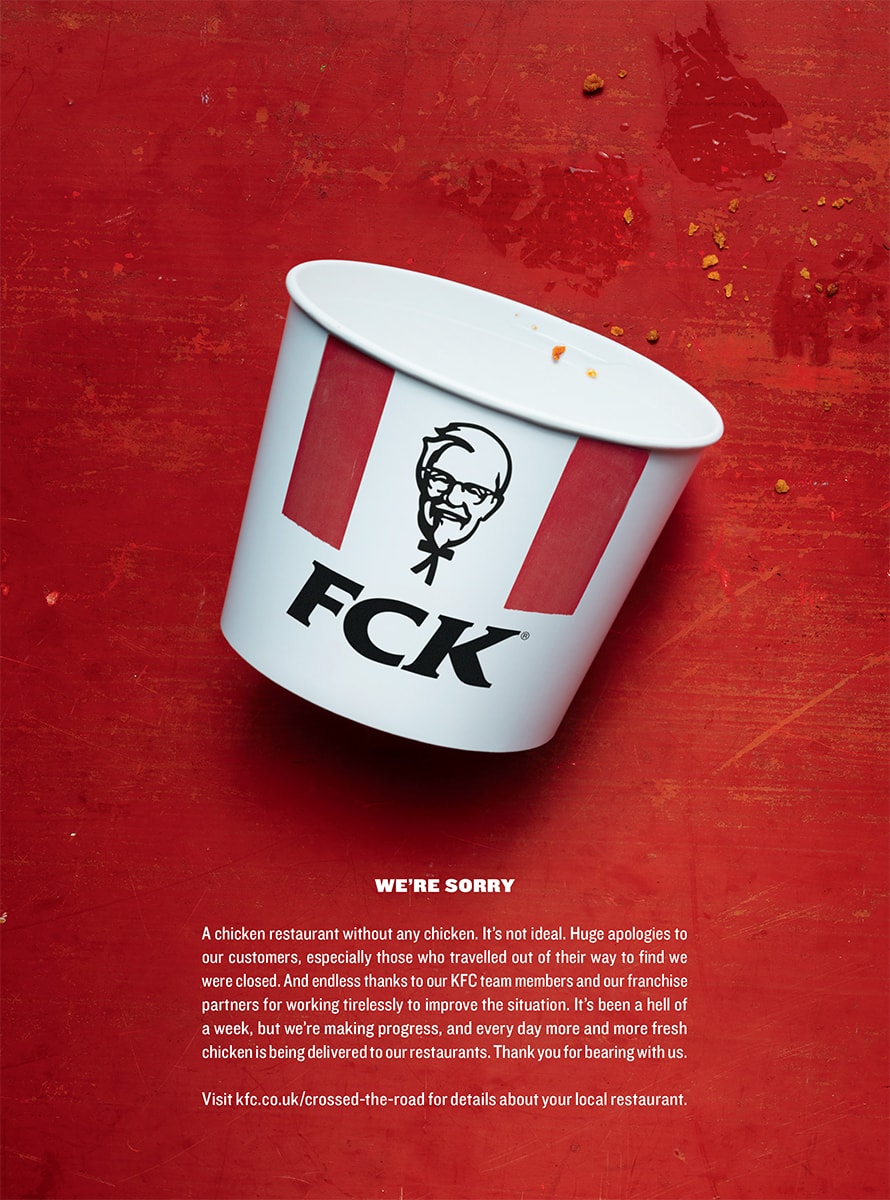
A brilliant ad. A brilliant PR strategy. This print piece from London agency Mother was a masterclass in both. When KFC’s British operation faced widespread backlash due to an unexpected chicken shortage that forced the closure of many locations, it was hard to visualize a response that could stem the tide of bad PR—much less reverse it. But working closely and quickly with the brand, Mother created a print ad headline for the ages: FCK. Humble yet humorous, dramatic but earnest, the ad showed that even an apology can be lovable if you find the right tone. How it was snubbed at the Cannes Lions and denied Grand Prix in both Print and PR, we’ll never know. But FCK is it a great ad.
2. Apple | “Welcome Home” Agency: TBWA\Media Arts Lab
One (probably valid) criticism of the most artistic and ambitious pieces in advertising history is that they often lack any real connection to the product and feel more like art for art’s sake. Not so with “Welcome Home,” the absolutely, arrestingly incredible spot created by TBWA\Media Arts Lab and director Spike Jonze for the Apple HomePod. The voice device kicks off a magical scenario that sees FKA twigs creating an expansive new reality within the confines of her cramped New York apartment—a metaphor anyone can appreciate for how sound quality can have a liberating effect on the soul. It’s one of the best ads of the year. It’s one of the best ads of all time.
1. Nike | “Believe in Something. Even If It Means Sacrificing Everything.” Agency: Wieden + Kennedy Portland
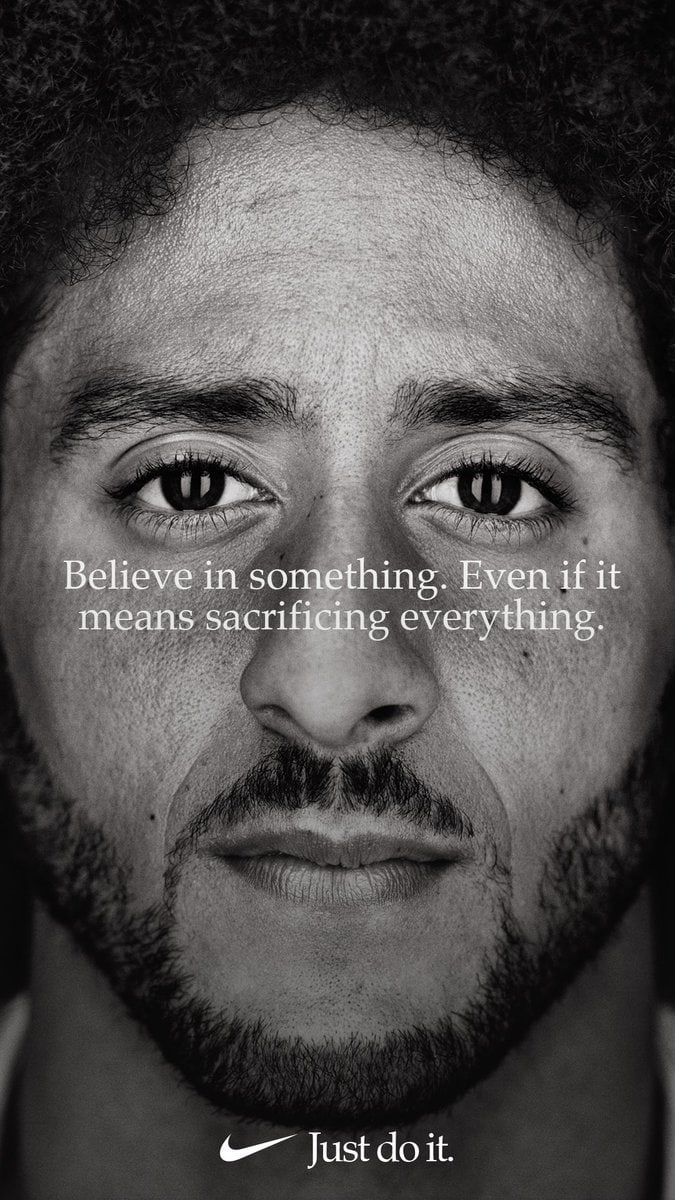
Simple. Powerful. Brave. Derided. And, ultimately, effective. Nike’s decision to kick off the 30th anniversary of the tagline “Just Do It” with an ad featuring polarizing quarterback Colin Kaepernick was one that, more than any other marketing move in 2018, sent shockwaves across nearly every corner of culture.
The art direction and copy were, like all immortal ads, deceptively simple: Kaepernick’s face and the headline “Believe in something. Even if it means sacrificing everything.”
Supporters of Kaepernick and other players who’ve knelt in protest of police violence against black Americans instantly rallied behind the ad, and his vociferous critics—including one President Donald Trump—were close behind. One ad, launched in a tweet, became a fulcrum for conversations that have divided a nation and vaulted the debate back to the top of all trending topics. Memes were made, and boycott threats flared up—as did some shoes that were burned by some who felt alienated by the endorsement—but just a few weeks later, Nike’s CEO credited the ad with sales boosts that reportedly added $6 billion to Nike’s valuation.
It was one of those very rare “turning point” ads that will be a reference point many years into the future. And perhaps most importantly, it will be the ad cited most often in settling the debate over whether a brand should take a stand.
That’s our list of our favorite ads for 2018. Was it missing a few of your favorites? Well, keep an eye out, because we’ve got even more coming as we prepare our roundup of the best stunts, activations and innovations that marketers attempted this year.
THE BIGGEST MISTAKES EXECS MADE IN 2018 AND HOW THEY'LL MOP THEM UP
Content Courtesy of: adage.com
Just when you thought it was safe to put last year in the rearview mirror -- it isn't. Operating under the notion that hindsight is 20/20, we asked industry executives what they did wrong in 2018—and how they plan to fix their mistakes in the new year. They did not hold back.
Jen Wong, chief operating officer, Reddit
"One of the things that Reddit could have done better is when we turned on ads, we should have had a more robust ads-free subscription product so that we had choice for our users. We've done that now, through Reddit premium. ... We should have done earlier."
Andrew Mok, CMO, Turo
"It's easy to get addicted to paid advertising—you put dollars in and see immediate dollars come back. We're seeing oftentimes it's smarter to reinvest that extra dollar in the form of loyalty incentives for your highest-value customers. The dollar not only comes back to you, but it'll compound over time. In 2019, we'll be focusing much more on rewarding our most loyal customers.">
Caren Pasquale Seckler, VP of social commitment, Coca-Cola North America
"The mistake we made over the years was really an opportunity cost. We were thinking about the social impact our company makes more through the lens of individual brands or initiatives. ... The reality is this generation of consumers is looking for what your total company stands for and does to make the world better. ... In the year ahead, we'll continue to focus our social commitment work to support our overall company brand."
Anselmo Ramos, founder, chief creative officer, Gut
"It would be easier to ask 'What didn't you do wrong in 2018?' Since 2018 was my first year being 100 percent independent, I was able to do almost everything wrong, and the best thing is, I didn't have to call New York or London before doing [it]. ... For 2019, I actually don't want to fix anything. I want to keep doing even more wrong things, only faster. That's the beauty of independence. The ability to be wrong."
Marisa Thalberg, global chief brand officer, Taco Bell Corp.
"Taco Bell is a brand that feels like an extrovert, so it might be surprising to admit that, if anything, it's possible we've been too demure about all the meaningful things this brand is doing with food, with our people and toward greater social good. In 2019 I'd like people to get to know this side of Taco Bell."
Tina Davis, managing director global branding and sponsorships, head of global sponsorship, Citi
"One thing I did 'wrong' was overcommit my time. With over-commitment comes under-delivery, and that can cause problems at work and at home. How do I plan to fix it in 2019? Focused and realistic time management. Balance work, learning, play, family, sleep—and embrace the positive power of 'no.'"
Tina Davis, managing director global branding and sponsorships, head of global sponsorship, Citi
Alvaro Luque, president and CEO, Avocados From Mexico
"One thing that we want to try to be better at is to be sure that we're reaching the right audience when we do our digital marketing. ... The first test that we did through Nielsen [on this] the numbers were not great. … We're now testing specific campaigns and partners throughout the year to be sure we're verifying that we're reaching the right audience and we'll start seeing the results in the coming year."
Rob Smith, founder and CEO, the Phluid Project
"We haven't yet been able to translate [the community we built in our brick-and-mortar store] online ... and consider this top priority as we come into 2019. We recently launched on crowdfunding site Republic in an effort to raise capital and bring [our] in-store [experience] online. We'll remedy this by streaming our celebrations and panel discussions, and creating video content with the intention of people spending as much time on the website as they do in-store."
Tommy Means, founder and chief creative officer, Mekanism
"I failed to show thanks. I'm surrounded by the most creative, giving and brilliant people that I've ever met. Every day these good folks show up for work and give the best of their hearts and minds. Sure, I say thanks, but showing thanks is a conscious decision that requires a deeper level presence, mindfulness and optimism. So, in 2019 I promise to show more gratitude."
THE BEST DIGITAL, INTEGRATED AND SOCIAL CAMPAIGNS OF 2018: A COUNTDOWN
Content Courtesy of: adage.com
Written by: Ann-Christine Diaz
As a final farewell to 2018, the editors of Ad Age's Creativity are highlighting the year's best brand ideas across a range of categories.
In this installment, we count down the top 10 outstanding ideas of the year in the realm of digital, integrated and social media. These campaigns gracefully leverage technology to imbue brands with heart, helpfulness and humor across a range of categories including food, publishing, automotive and tech.
No. 10: Google Arts & Culture, "Art Selfie"</strong
Google "elevated" the art of the selfie with this tool added to its Arts & Culture app that matched your face with countenances captured throughout history in classic and modern art. When it debuted in January, the app went straight to the top of Apple's download charts. Our social feeds became flooded with friends' painterly doppelgangers and we couldn't stop playing with it ourselves. We tried it again recently and it's still plenty of fun-- and it seems even more mugs have been added to the mix.
No. 9: Mini, #MINIonDemand</strong
Twitter is not just a platform for timely updates. You can also use it to order pizza and this year, thanks to BMW's Mini, you can use it to summon a car for a test drive. This fall, the auto brand partnered with the social platform to allow car buyers in L.A. and San Francisco to have a Mini Countryman delivered to their door for a 30-minute test spin, just by tweeting with the hashtag #MINIonDemand..
No. 8: RX Bar, "No B.S."</strong
This campaign for Kellogg-owned RX Bar from Wieden & Kennedy Portland proved you don't need a big production to capture attention. No-frills online videos depicted rapper and actor Ice T popping out of a door and telling it like it is: "Hi, I'm famous and this is a commercial," he says in one. The campaign promoted the brand's no-B.S. approach to nutrition and also included a hotline that turned viewers' B.S. beefs into animations. The effort from around 8 percent to 15.3 percent mid-way through the campaign's run, according to RX Bar.
No. 7: Sonos and the Nasdaq Market Bell</strong
Sound has played an increasingly important role in advertising and marketing, and we found this idea to be the most inventive in this space in 2018. Audio electronics firm Sonos asserted its commitment to top-quality sound when it redesigned the "ring" of the Nasdaq bell to coincide with its own initial public offiering. The idea also dovetailed with Nasdaq's own branding refresh, as the company has more pointedly embraced a focus on technology and the idea of "relentless possibility."
No. 6: MGM Resorts, "Universal Love"</strong
Inclusivity now seems to be a given in marketing messages, but this idea for MGM Resorts from McCann New York embraced it in a whole new way -- it tapped top recording artists including Bob Dylan, Kesha and St. Vincent to re-record classic loves songs to create a LGBTQ wedding album. The campaign also included a music video for Kesha's rendition of a Janis Joplin tune, "I Need a Woman to Love Me," which saw the artist, an ordained minister, presiding over a same-sex wedding at the Bellagio Hotel.
No. 5: Schweppes, "The Dress for Respect"</strong
Ogilvy Brasil and beverage brand Schweppes created a dress outfitted with sensors that recorded when its wearer was touched without consent -- and the results of the experiment were revealing. The campaign did not merely use tech for tech's sake. Rather, it leveraged technology to help open viewers' eyes to the pervasiveness of sexual harassment in a year dominated by #MeToo headlines.
No. 4: Times of London, "JFK Unsilenced" Agency: Rothco
Irish agency Rothco and the Times of London leveraged data to allow the world to finally hear the speech John F. Kennedy was meant to deliver in Dallas had he not been assassinated in 1963. The agency teamed with an audio tech company to analyze more than 800 of JFK's analog recordings in order to reconstruct his words--which prove to have startling resonance in today's current political climate. The campaign went on to win the 2018 Cannes Lions Creative Data Grand Prix.
No. 3: Domino's, "Paving for Pizza" Agency: Crispin Porter Bogusky
Domino's Pizza has earned a reputation as a technology company that's a fast-food brand in disguise with innovative digital ideas such as Twitter ordering. So in 2018, we were tickled when the pizza purveyor debuted this departure from the tech wizardry. "Paving for Pizza," an idea conceived by Domino's longtime agency Crispin Porter Bogusky, encouraged consumers to report their neighborhood's faulty roads, and Domino's would help repair them in an effort to ensure that their pies would get to consumers intact. Customers submitted more than 137,000 nominations from 15,275 ZIP codes, and even municipal governments and community groups encouraged citizens to participate. So far, Domino's has paved roads in 13 cities and has expanded to program to pave roads in at least one community in each of the 50 states.
No. 2: The New York Times, "Overlooked"

For International Women's Day in March, the New York Times set out to right a huge wrong when it posthumously published obituaries of important women in history it failed to feature when they passed. The "Overlooked" project began with obits covering the contributions of investigative reporter Ida B. Wells, poet Qiu Jin and photographer Diane Arbus and has continued with more recent pieces on Texas author Gertrude Beasley Indian princess and British spy Charley Parkhurst the one-eyed stagecoach driver whose gender identity remained hidden throughout her adult life. The project debuted alongside a new spot in Droga5's ongoing campaign for the Times centered on how "The Truth Is Hard."
No.1: The March for Our Lives (and beyond)

A group of indefatigable young men and women refused to let the gun violence problem in U.S. become yet another blip in the news cycle, spawning one of the year's most powerful cultural movements. The students of Marjory Stoneman Douglas High School in Florida made certain that mass shootings would remain top of mind for both politicians and voters through their dogged social media efforts and impassioned activism mobilizing supporters for the March for Our Lives.

Price tag from 'Price On Our Lives' campaign Credit: March for Our Lives
Their work inspired many others to amplify the message with outstanding creative ideas, including McCann New York's "The Vicious Cycle," a stirring music video that carried the cause to the midterm elections; the agency's "Price on Our Lives" effort that featured price tags students could wear to reflect how much they were "worth" to politicians who accept money from the NRA gun lobby; and an Instagram coloring book from BBH.
